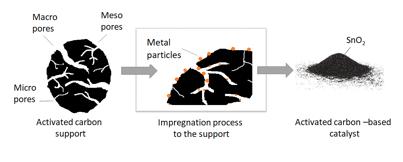After the carbonization and activation process, the activated carbons are used in the variation of applications. Depending on the application, the activated carbon can be treated for example with different acid treatments to remove the remaining mineral content origin from the biomass of the preparation process, or to modify the surface to contain specific functional groups. In catalytic applications, the activated carbon is used as a support material for various metals or metal oxides. Activated carbon supports with high surface areas can generate large contact areas for metals when used in specific conversion reactions. Metal salts are usually added by impregnation method to the support and treated by heat-treatment to obtain corresponding metal or metal oxide on the support, see Figure 27. Depending on the catalytic application, catalysts are tested in the gas or liquid phase for the conversion reactions.
Figure 27. Preparation of activated carbon-supported metal catalysts (Kupila, 2021)
In the project, the activated carbons have been used as such in the catalytic conversion reaction or modified with acids and/or metals for the catalytic applications. Used metals for the catalytic experiments have been zinc, aluminum, tin and iron. The prepared activated carbons and supported metal catalysts have been characterized through multiple analysis methods and tested in the catalytic applications for the conversion of biomass-based molecules to valuable bio-based platform chemicals.
2.3.3 RESULTS The obtained hydrolysis lignin from the biomass hydrolysis was used as such in the carbonization and activation process. Also chemically pretreated hydrolysis lignin to modify the lignin structure was tested. In the preparation process, physical activation (with steam) and chemical activation (with ZnCl2 and H3PO4) were used. Depending on the activation process i.e. used activator agent, time and temperature, prepared activated carbons had varied qualities. Results are presented in Table 4. Steam activation of the hydrolysis lignin gave the surface area of about 400-850 m2/g with a mostly microporous structure. At lower temperatures (600-700 °C), lower surfaces areas were obtained with steam activation. It was noted that the pretreatment of the hydrolysis lignin with different chemicals (e.g. oxidation and methylation) didn’t give a higher surface area compared to the untreated hydrolysis lignin. When the chemical activation was applied to the process, typically higher surface areas were obtained over 1500 m2/g. With ZnCl2 as activating agent reached 1500 m2/g surface area and micro-mesoporous structure were obtained. With H3PO4 activation, the surface areas were even higher and approximately 1800 m2/g surface areas were obtained. Also, yields of the activated carbons obtained with chemical activation were higher than those obtained from physical activation with steam. The ash content of the lignin-based activated carbons was rather low and was less than 3 wt. %. It could be concluded that high quality activated carbons were able to prepare from hydrolysis lignin and depending on the preparation method, varied features (e.g. surface areas and porosity) were obtained for the carbons, which could be applied to specific applications.
24
GREEN BIORAFF SOLUTIONS








